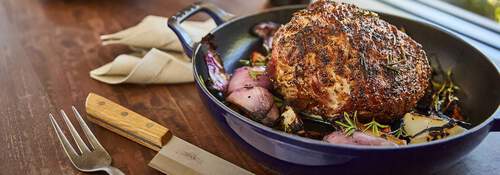Why is Red Wine "Red"?
Red wines are defined by the contact the juice has with its red grape skins. The juice is fermented (aka turned into wine) while in contact with its skins, giving red wines their color, texture and taste, mostly from the tannins.
Although a seemingly stuffy wine word – tannins are to thank for a lot of the characteristics you appreciate about red wine. In addition to fermentation on the skins, red (and white) wines can also pick up tannins from aging in oak barrels.
Technically speaking, tannins are groups of molecules that bond together, so for our sake, let's call them elements. These elements come from all parts of a grape, including the seeds, skins and stems. So, when a red wine is put in contact with these elements, it takes on their characteristics, which are typically drying in nature.
Full-Bodied & Bold Reds
Warm the senses with a balance of bold dark fruits and spice. Full-bodied and rich tasting, these wines deliver the spirit of cozy nights by the fire.
DRY
SWEET
FRUITY
TANNIC
LIGHT
HEAVY
Medium-Bodied & Fruity Reds
These wines are wonderful food companions – well-balanced and not overly tannic.
DRY
SWEET
FRUITY
TANNIC
LIGHT
HEAVY
FAQs
1. Which red wines are the best to drink?
“Best” depends on your palate. Tasting notes, acidity, and the body of wine all play a factor in your preference. If you’re looking for something the critics have praised, try the Estancia Cabernet Sauvignon, which received 91 Points from Wine Review. Reasonably priced ($13.99), layers of dark berries create a velvety mouthfeel, underscored by threads of lightly toasted oak, caramel and a drop of raspberry on the finish.
2. Which red should I drink if I want something sweet?
We’ve got several sweet reds to choose from. For a spiked rich red blend with hints of caramelized orange, try Lolli Sweet Spiked.
3. Can I cook with red wine?
Absolutely! Cooking with red wine enhances the flavors of savory, bold dishes, like marinated steak and beef stew. We recommend using Cabernet Sauvignon, Pinot Noir, or Merlot when cooking—the acidity of these wines tenderizes meat. When simmered, the alcohol evaporates but leaves all the delicious tasting notes.
4. Do I need a special glass?
It depends on the type of red wine you’re pouring. For a bold red, like Cabernet Sauvignon or Zinfandel, a larger glass with a wide opening is best; this allows the aromas and flavors to breathe (it’s also a great glass for Merlot). For Grenache, a standard red wine glass with a smaller opening is ideal to soften the spice notes, while Pinot Noir is divine in a Burgundy glass, as its larger bowl highlights the wine’s delicate aromas.
5. When do I drink red wine?
Red wine can be enjoyed throughout the year, but we do have some suggestions! Pair the fall season with a fruit-forward, oaky Pinot Noir. Enjoy a full-bodied, rich Cabernet Sauvignon in winter and a Genache with floral and herbal notes in the spring. Come summer, pour a Merlot that has layered notes of ripe berries.
Red Wine Food Pairings
Whet your appetite with some of our favorite recipe pairings!

.jpeg?sw=500&sh=500&sm=fit&q=65)

